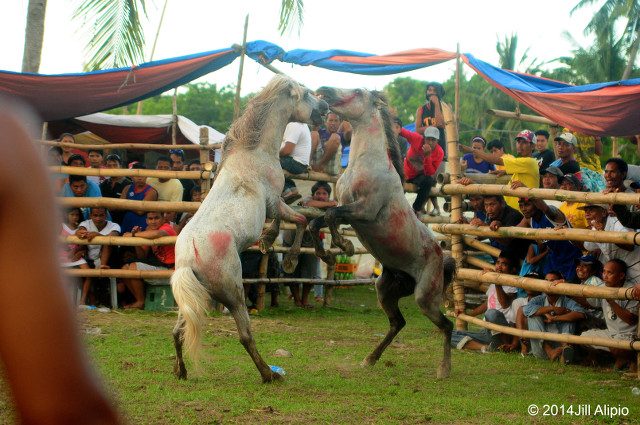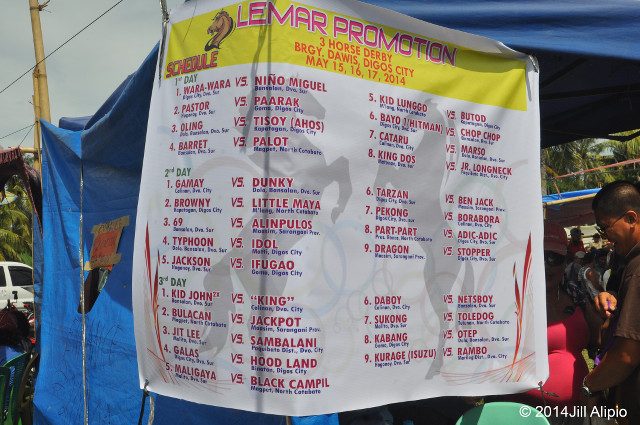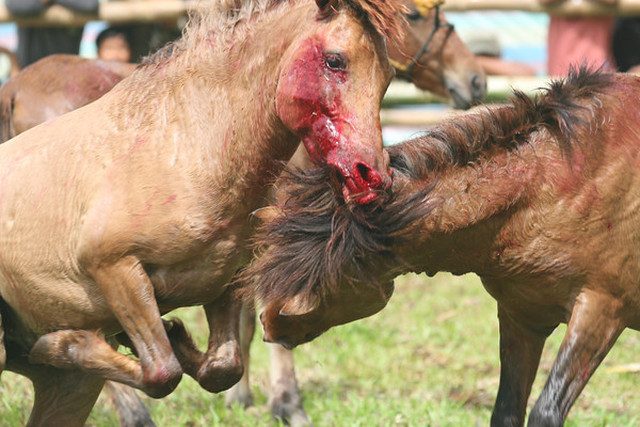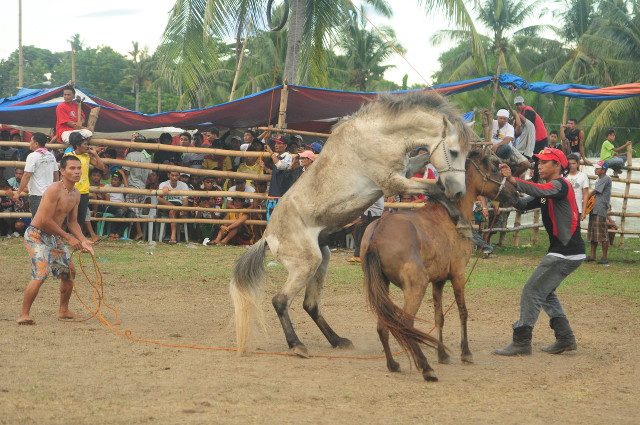SUMMARY
This is AI generated summarization, which may have errors. For context, always refer to the full article.

MANILA, Philippines – “Bratatatatatatat!” blares a commentator as two white male horses fight to the death in the village of Dawis, Digos City, Davao del Sur.
Their flanks, tense with the threat of violence, are matted with blood and dirt. After biting his adversary on the neck, one horse paws the ground like a bull.
The crowd goes wild and unseen whistles screech in ecstasy. The children, watching from nearby tree branches, cheer along with their elders, making private bets among themselves.
Recorded in video by animal rights group Network for Animals (NFA), the horse-fighting derby allegedly took place on May 16, 2014.
It is one of dozens of horse-fighting events that take place in Mindanao provinces every year.
This is in violation of Republic Act No 8485 or the Animal Welfare Act of 1998 which prohibits horse fights and the maltreatment of horses. Anyone engaged in horse-fighting can be imprisoned for 6 months to 2 years and fined P30,000 to P100,000 ($676-$2,200), depending on whether or not the horse dies.
In a horse fight, two male horses are put in a ring with a mare in heat. The stallions are goaded to mate with the mare and then restrained in order to induce aggressive behavior.
Once violent enough, they are released so they can fight over the mare.
The cruel practice, which leaves hundreds of horses dying or severely injured, has been going on in the region since the 1980s, according to NFA Philippines.
Aggressive campaigning has led two governors – Jose Zubiri of Bukidnon and Emmylou Taliño-Mendoza of North Cotabato – to ban horse-fighting events in 2014.
But insiders say those who make big bucks from horse-fighting have changed tactics to avoid the law.

NFA, who has been investigating the practice since 2009, says that in fact there are already two derbies scheduled for 2015: one from April 24 to 26 in San Isidro, Valencia, Bukidnon and another from July 12 to 14 in Sinoda, Bukidnon.
Zubiri, informed by Rappler about the supposedly planned fights, has committed to inform the concerned mayors.
It’s a follow-through of an ordinance he released last June 2014, ordering all Bukidnon mayors and police to stop any horse fights held in their areas of jurisdiction.
But the big profits from horse-fighting events ensure the practice is here to stay unless strong enforcement and political will intervene.
Big bucks
NFA Philippines head Mel Alipio first heard of horse-fighting in Mindanao in 1988. Locals explained to him that at first, it was a form of entertainment for remote villages of the indigenous lumads “where there was no television.”
Promoters earn not less than P500,000 per derby
– Mel Alipio, Network for Animals
Through the years, gambling was introduced, increasing the number of fights organized during village fiestas. High financial gains have spurred massive funding leading to more well-organized games, higher attendance, and eventual acceptance by communities.
In 2009, NFA recorded 13 horse fight derbies. In 2014, there were 20. In both cases, a majority of the fights (7 and 6, respectively) took place in Bukidnon.
Today, grand prizes range from P100,000 to P1 million ($2,200-22,500). Participants bet anywhere between P10,000 to P1 million ($225-$22,500) on a horse.
The organizers – called “promoters” – of events earn at least P500,000 ($11,300) per derby, Alipio told Rappler. This is even after spending for transportation of the audience from the village to the derby venue, food, and honorarium for the referees, called “cowboys.”
They also earn from entrance fees – P300 per person or up to P500 ($6.8-11) per person for derbies with the best horses.
To top it off, they get high-rollers to sponsor the derbies. One derby held in June 2014 was allegedly sponsored by a Mindanao governor and was attended by several public officials.

A vice-governor even gave the welcoming remarks and personally handled “bundles of thousands of money submitted by cristos or bet collectors,” said NFA’s Jill Alipio who was at the derby.
But promoters get the biggest profits from taking 10% to 20% of all the winnings of victorious bettors.
It’s not easy to forego all that money because of an ordinance.
Mel Alipio said organizers are now more careful. They limit the duration of derbies to one day from the usual 3 days. They now take place in even more secluded areas, far from town or village centers. And if they used to ask for permits from LGUs to hold the event, they now refrain from doing so.
Slow, painful death
While human gamblers and organizers are salivating from the promise of big winnings, the horses are salivating in fear during a fight.
For them, horse fights are a prelude to a tortuous death.
A veterinarian who requested anonymity said that the horses usually die from internal bleeding after a kick from his adversary.
“Because a kick is more painful than a bite. The kick of a horse from behind is 10 times more powerful than [Manny] Pacquiao. Two days after, sometimes, one week after, they die. That’s a slow, very painful death. Others are just killed off by their owners,” he told Rappler.
Horses sustain severe injuries from biting. Jill Alipio said she has seen a horse bite off another horse’s testicles. Another time, a horse’s jaw was dislocated.
“Ganyan ka-cruel ang mga tao. Alaga, partner sa life, iaaway. Kung tingin nila hopeless, papatayin nila (That’s how cruel humans are. A pet, a partner in life, then they are made to fight. If they are hopeless, they will be killed),” said the veterinarian.
Injured horses have been forced to fight for 5 hours. Recently though, organizers have imposed a one-hour limit – not out of kindness but to give other pairs a chance to fight, said Alipio.

Cruel also is the training regimen the fighter-horses must endure.
One practice is teaching a horse how to “box” by holding them up with rope and forcing them to jab the air as if they were boxing.
To teach the horse to be merciless, they are put in a fake arena with a goat which they are expected to clobber to death.
Some horses become so aggressive that, in more than one instance, they have killed their masters, said Alipio.
Bigger battle
But with the ordinance and presence of concerned animal rights advocates, a greater battle is taking place outside the ring.
Penalties for engaging in horse fights:
- 6 months-2 years in prison
- P30,000-P100,000 fine
– Animal Welfare Act of 1998
NFA has been attempting to wean off people from the culture of horse-fighting. Alipio said they have been around Bukidnon, Davao Del Sur, and Cotabato offering free vaccination for horses.
“During vaccination, before injection we say we will attend to this animal, we will give you medicine, we will give vitamins to the malnourished, but if possible don’t make them fight. The next time we see you, we won’t attend to your horse. Because what’s the use, we will cure them then you will make them fight?”
But the going is tough. Even if people did start to take pity on their animals, the lure of money often overpowers, said Alipio.
Horse-fighting organizers also often have strong ties with political figures or wealthy businessmen who themselves stand to gain from the horsefights.
A cycle of greed and connivance traps the horses better than any bamboo ring would.
But progress has been made. Three months after the anti-horse-fighting ordinance in Bukidnon was issued in June 2014, police were able to stop a derby being held in Mandaing village, Cabanglasan in Bukidnon.
But the derbies are likely to continue if the organizers or funders remain at large.
The Animal Welfare Act of 1998 is supposed to protect horses. But can a law stand up to an entrenched practice? Or will horse-fighting evolve to be as accepted as cock-fighting?
The more delayed the answer, the more horses will fall, bloodied, inside the ring. – Rappler.com
Add a comment
How does this make you feel?
There are no comments yet. Add your comment to start the conversation.